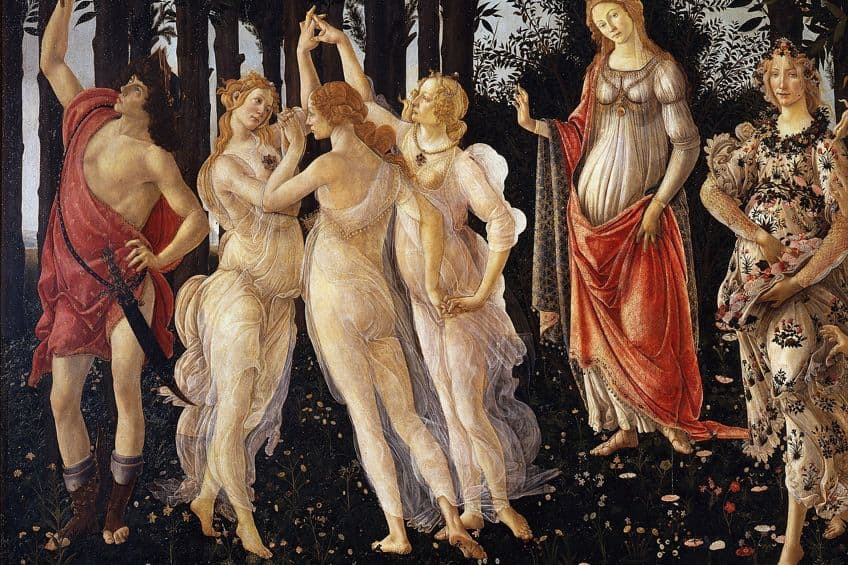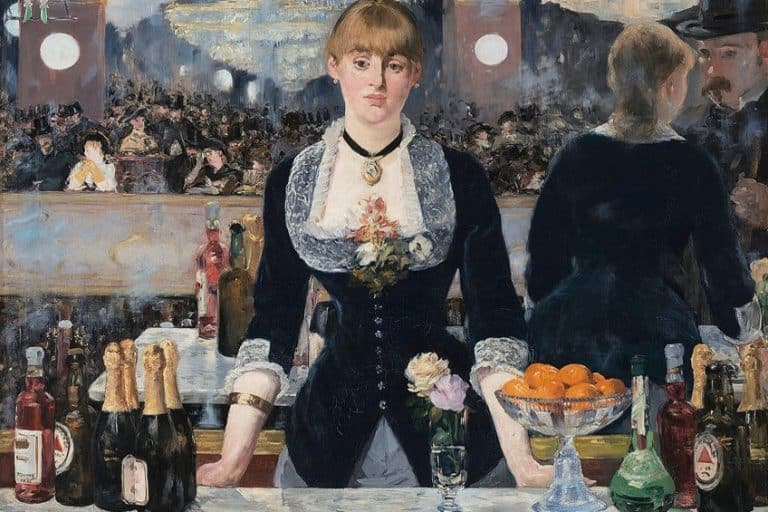The Three Graces by Sandro Botticelli – An Artwork Analysis
Sandro Botticelli’s Primavera is a celebrated masterpiece of the Italian Renaissance, renowned for its intricate symbolism and rich allegorical themes. At the heart of this iconic painting lies the depiction of the Three Graces, ancient Greek goddesses symbolizing beauty, charm, and creativity. Positioned prominently amidst a lush garden, these ethereal figures embody the spirit of spring and renewal, adding a sense of grace and harmony to the composition. Botticelli’s meticulous attention to detail, vibrant color palette, and masterful composition elevate Primavera to a pinnacle of Renaissance artistry, inviting viewers to explore its layers of meaning and timeless beauty.
Table of Contents
Key Takeaways
- Botticelli’s La Primavera is a revered Renaissance painting that features the Three Graces.
- The Three Graces symbolize a blend of classical virtues and humanistic themes prevalent during the Renaissance.
- The artistic significance and lasting cultural impact of the Three Graces in art history are monumental.
Who Are the Three Graces?
| Artist | Sandro Botticelli (c. 1445 – 1510) |
| Date Created | Late 1470s or early 1480s |
| Medium | Tempera on panel |
| Genre | Mythological painting, Renaissance |
| Period/Movement | Italian Renaissance |
| Dimensions (cm) | 202 x 314 |
| Series/Versions | Single version, no known series |
| Where Is It Housed? | Uffizi Gallery, Florence, Italy |
| What It Is Worth | Priceless, is considered one of Botticelli’s masterpieces |
The Three Graces are mythological figures originating from Greek and Roman mythology, known for symbolizing beauty, charm, and grace. They are commonly referred to as Aglaea (Splendor), Euphrosyne (Mirth), and Thalia (Good Cheer). Each Grace represents a different aspect of the overarching concept of graciousness and allure. In Sandro Botticelli’s artistic renditions, the Graces are depicted as elegant and harmonious figures, often clothed in diaphanous robes or less frequently, presented nude to emphasize their divine nature. They are typically positioned close together, embodying the unity of their attributes.

Symbolism
- Beauty: Their presence in art is frequently associated with the flourishing of nature and the arts.
- Influence: The Graces have inspired many artists beyond Botticelli, including Raphael and Picasso, to explore themes of beauty and harmony.
Botticelli’s commitment to depicting the Three Graces has left a significant legacy in the art world, immortalizing these deities as perpetual symbols of grace and inspiration.
Botticelli’s Interpretation
- La Primavera: In this piece, the Graces are featured dancing in a circle, a pose that encapsulates the bond between them. They are often appreciated for their idealized form and ethereal movement, further enhancing the painting’s theme of spring’s arrival.
- Venus and the Three Graces Presenting Gifts to a Young Woman: Another example of Botticelli’s work where the Graces accompany Venus, highlighting their connection to the goddess of love and beauty.
Historical Context and Commission
Sandro Botticelli was a key figure of the early Renaissance period, advancing the arts through his masterful paintings. Central to the flowering of artistic innovation in Florence, his work La Primavera, commissioned by the powerful Medici Family, remains an unparalleled example of Renaissance artistry.

The Three Graces in Botticelli’s La Primavera
Botticelli’s La Primavera, painted in the late 1470s or early 1480s, features a group of figures known as The Three Graces—three women depicted with ethereal beauty, representing chastity, beauty, and love. These figures embody the neoplatonic ideals popular in Florence at the time, ideals that were supported by the Medici Family. The patronage of the Medici, particularly Lorenzo de’ Medici, was instrumental in the birth and sustenance of Renaissance culture.
The commission of La Primavera is believed to have been for a member of the Medici circle, possibly to commemorate a matrimonial alliance.
As an Italian Renaissance Painter, Botticelli was influenced by the Medici’s humanistic approach to art and philosophy, encapsulating not only aesthetic beauty but also the intellectual spirit of his era within his works. La Primavera stands as a testament to the Medici’s role as benefactors of the arts and culture, which brought about a renaissance of classical ideals melded with contemporary Florentine aesthetics.
Artistic Analysis
This section delves into the artistic merits of Sandro Botticelli’s the Three Graces, exploring its intricate symbolism, technical excellence, and influence on Renaissance art, as well as the efforts undertaken to preserve this masterpiece.
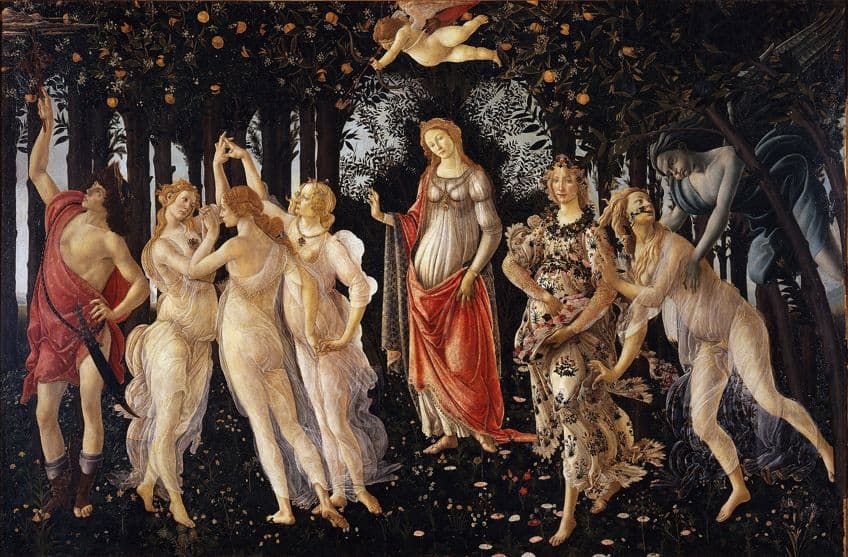
Symbolism and Allegory
The Three Graces in La Primavera, also known as Spring, represent a trio of mythological figures that symbolize beauty, charm, and grace. They stand to the left of Venus, the goddess of love, reinforcing the allegory of fertility and the flourishing of nature. Cupid, hovering above, aligns with Venus to complete the tableau of love and beauty.
Through the characters, Botticelli conveys a narrative steeped in Ancient Greek mythology, with Venus at the center signifying humanistic values.

Technical Aspects
Botticelli’s approach in depicting the Three Graces showcases his mastery of line and form, coupled with a delicate use of color and space. The figures are drawn with flowing lines that create softness and movement, a hallmark of Botticelli’s style, evident as well in his later work, The Birth of Venus.
The application of tempera, with its bright and enduring color palette, contributes to the painting’s visual appeal and longevity.

Influences and Comparisons
The depiction of classical figures like the Three Graces reflects the Early Renaissance’s reverence for antiquity. Botticelli, having studied under Fra Filippo Lippi, was influenced by his teacher’s line-based style. Moreover, Botticelli’s interpretation of mythological subjects inspired contemporaries and later artists, such as Raphael and even Pablo Picasso.
He did this by setting a precedent in the portrayal of classical harmony and beauty.
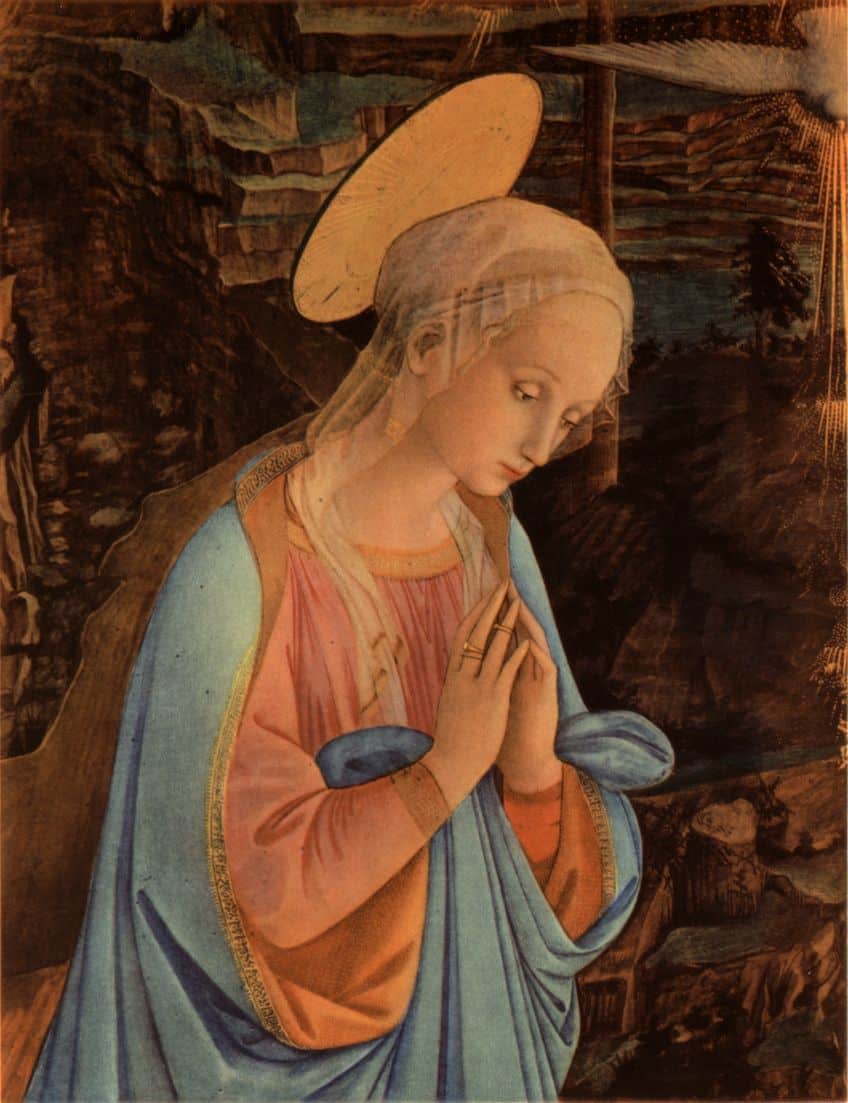
Restoration and Preservation
La Primavera, along with Botticelli’s representation of the Three Graces, has been subject to rigorous preservation efforts to maintain its condition. Housed in the Uffizi Gallery, careful restoration practices ensure that Botticelli’s delicate tempera on wood technique remains stable, and that its vibrant color and line work.
This made the artwork a mainstay of Italian Renaissance art, visible for future generations.
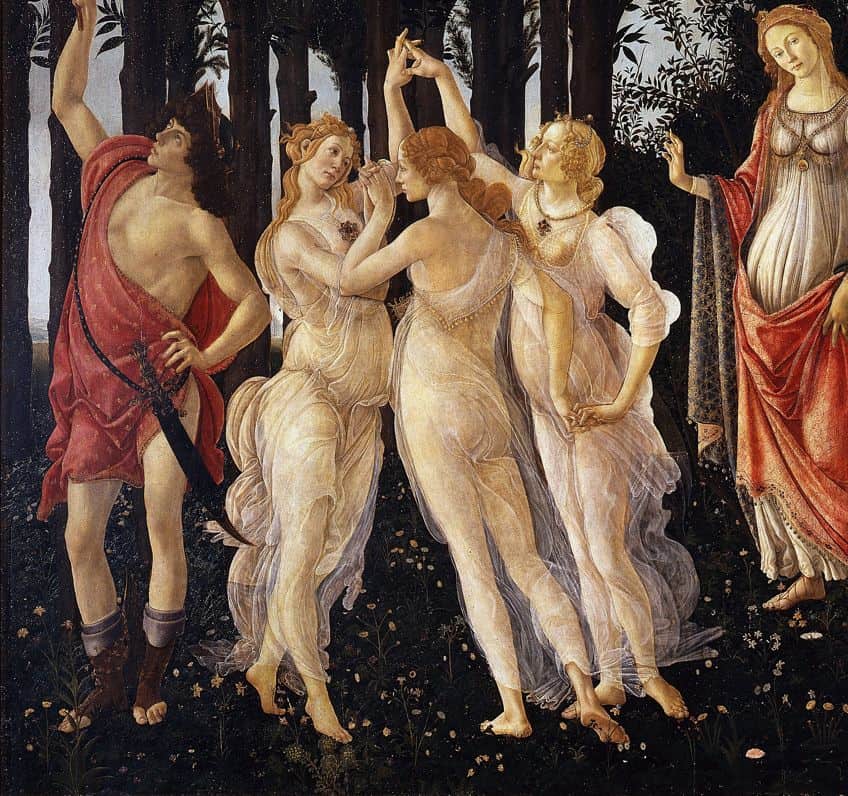
Cultural Impact
The Three Graces in Sandro Botticelli’s La Primavera have left an indelible mark within the scope of Western art, significantly influencing subsequent generations of artists. The representation of these mythological figures exemplifies a blend of Neoplatonism and Humanism, ideologies that pervaded the Italian Renaissance. The fusion of classical philosophy with pagan symbolism in the painting underscores a cultural reawakening to the values of beauty, love, and fertility—the very attributes the Three Graces embody.
- Philosophy: Their depiction echoes Renaissance humanist philosophy, which centered on the potential of human achievement.
- Mythology: As mythological entities, the Three Graces represent a harmonious balance, inspiring Renaissance interest in Greco-Roman myths.
- Pagan: Pagan themes within La Primavera highlight the Renaissance era’s renewed interest in pre-Christian culture and ideas.
- Love and fertility: Art historians interpret the Three Graces as allegorical figures of both earthly and divine love, blooming from the fertile grounds of the Renaissance intellectual landscape.
These thematic currents ripple through Western art history, underscored by shifts in attitudes coming from Renaissance Europe’s revitalized engagement with the ancient world.
La Primavera, a painting that continues to generate discussion and attraction, emblemizes the cultural dialogue between antiquity and Renaissance modernity that was propagated through art itself.
Legacy of the Three Graces
The iconic depiction of the Three Graces in Sandro Botticelli’s La Primavera is a masterful representation that has had a profound impact on art history. These figures, symbolizing beauty, charm, and joy, appear as a cohesive unit embodying the Renaissance ideal of perfect harmony and humanism.
Botticelli’s influence extended to a number of Renaissance artists, who sought to emulate the grace and elegance captured in his work. The Three Graces, with their ethereal presence, became a recurring motif in the art of the period. Giorgio Vasari, the renowned art historian, praised Botticelli, acknowledging the significant contribution he made to art during the Renaissance. La Primavera was particularly noted for its intricate symbolism and composition. Niki de Saint Phalle, a 20th-century artist, took inspiration from classical elements such as The Three Graces. Her bold, colorful sculptures echo the timeless tribute to femininity and beauty seen in Botticelli’s work.

The Three Graces transcended the confines of fine art, influencing popular culture and continuing to serve as a symbol of artistic beauty. Their interpretation through the hands of Botticelli is emblematic of the humanist spirit of the time. Another of Botticelli’s works, Venus and the Three Graces presenting gifts to a Young Woman, extends the legacy, highlighting the continued relevance of these mythological figures. They represent a gift of beauty and favor imparted to humanity.
In summary, the legacy of the Three Graces as portrayed by Botticelli set a standard for beauty and harmony that resonated throughout the art world, influencing a myriad of artists and becoming a cornerstone of Renaissance art interpretation.
In conclusion, Sandro Botticelli’s depiction of the Three Graces in Primavera stands as a testament to his artistic genius and deep understanding of mythological symbolism. The graceful presence of these goddesses adds a layer of enchantment and elegance to the painting, enhancing its narrative of springtime and rejuvenation. Through intricate details, vibrant colors, and a harmonious composition, Botticelli creates a timeless masterpiece that continues to captivate and inspire viewers across generations. The Three Graces in Primavera not only symbolize beauty and charm but also serve as a symbol of the enduring allure and artistic brilliance of the Italian Renaissance.
Frequently Asked Questions
What Is the Iconography of the Three Graces in Primavera by Botticelli?
In Primavera, the Three Graces represent feminine virtues. They are typically identified as Chastity, Beauty, and Love. Their sheer, almost translucent garments and the harmonious way they interact with each other reflect the Renaissance ideals of beauty and purity. Their presence is emblematic of the joy and fertility that spring brings.
How Do the Three Graces Contribute to the Overall Theme of Primavera?
The Three Graces in Primavera stand as symbols of the beauty and harmony of nature, enhancing the painting’s overarching theme of spring and rebirth. Their elegance and connection to each other embody the unity and gracefulness that the season of spring represents, fitting seamlessly into the tapestry of allegory and mythology Botticelli depicts.
Isabella studied at the University of Cape Town in South Africa and graduated with a Bachelor of Arts majoring in English Literature & Language and Psychology. Throughout her undergraduate years, she took Art History as an additional subject and absolutely loved it. Building on from her art history knowledge that began in high school, art has always been a particular area of fascination for her. From learning about artworks previously unknown to her, or sharpening her existing understanding of specific works, the ability to continue learning within this interesting sphere excites her greatly.
Her focal points of interest in art history encompass profiling specific artists and art movements, as it is these areas where she is able to really dig deep into the rich narrative of the art world. Additionally, she particularly enjoys exploring the different artistic styles of the 20th century, as well as the important impact that female artists have had on the development of art history.
Learn more about Isabella Meyer and the Art in Context Team.
Cite this Article
Isabella, Meyer, “The Three Graces by Sandro Botticelli – An Artwork Analysis.” Art in Context. March 25, 2024. URL: https://artincontext.org/the-three-graces-by-sandro-botticelli/
Meyer, I. (2024, 25 March). The Three Graces by Sandro Botticelli – An Artwork Analysis. Art in Context. https://artincontext.org/the-three-graces-by-sandro-botticelli/
Meyer, Isabella. “The Three Graces by Sandro Botticelli – An Artwork Analysis.” Art in Context, March 25, 2024. https://artincontext.org/the-three-graces-by-sandro-botticelli/.


